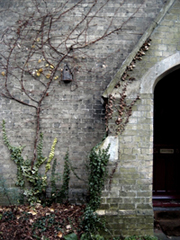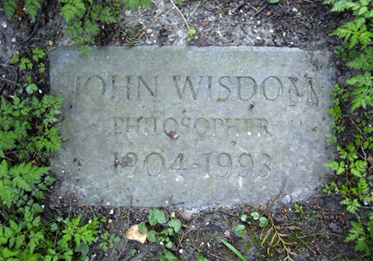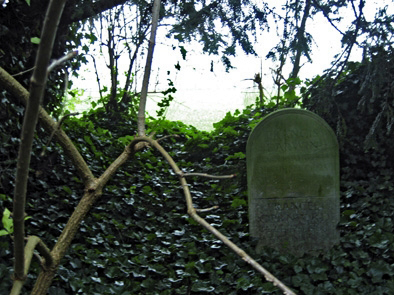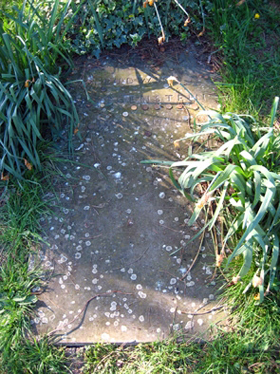Human Flower Project
Monday, December 10, 2007
By Way of St. Giles
Taking the long way, through Walden Pond, the Spanish Civil War and Larkin’s poetry, writer John Levett gets up to speed.
 Churchyard wall
Churchyard wall
at St. Giles
Cambridge, England
Photo: John Levett
By .(JavaScript must be enabled to view this email address)
The fine Journal of The Philip Larkin Society, imaginatively entitled “About Larkin” (took some thinking-up did that), arrived this week—Number 24, all twenty-four of which can now be had for £115 which seems steep to me but why complain while it seems I’m sitting on a goldmine.
I joined up some decade or so ago just as it was starting up, joining up to some half-dead but still resonant connection I had with Larkin, Hull and a sunny afternoon in October 1964. I remember a December afternoon a couple of years ago having a splendid chat in The Eagle (a local pub famed for stuff) with a student who was writing a dissertation on Larkin and his readership, and he asking if Larkin predominantly appealed to a particular generation and me agreeing; being of that generation born in a decade spanning 1940 and remembering England (always England, never Britain) in its shoddy 1950s parochialism, its frayed & faded threads of Empire and influence. I read Larkin and know why I do. More to do with a time rather than timelessness, I can’t take Larkin out of a time in my life and his.
Back to “About Larkin.” There’s a quote from “Autumn” (1953, Coronation, conquest of Everest, how we cheered!) and its phrases catch: “the year goes suddenly slack”; “And summer, that keeps returning like a ghost, Of something death has merely made beautiful.” Last Tuesday I took myself off on a sad, spitting afternoon on the road out to Girton to St. Giles burial ground (it’s called something else these days but I can’t recall what and it’s probably got corporate sponsorship and a Health and Safety Certificate as well).
Burial grounds are ripe for encouraging bad photography and even worse amateur poetry. When I arrived in Cambridge in the mid-‘90s I got wind of Wittgenstein having been buried there. I’d invested time over decades in LW so went looking for his remains. The stone, scattered once with coins (I wish, I wish, I wish…) was appropriate, as sparse and downbeat as his alleged deckchair in his room at Trinity. It’s more washed out now, coinless but with candle (disgracefully extravagant).
 Philosopher with ferns
Philosopher with ferns
St. Giles burial ground
Photo: John Levett
I’ve kept going back there every year or so, usually for want of somewhere fresh to walk to, someone new to trip over—economist Alfred Marshall in a corner, scientist Max Perutz in inappropriate off-white, the appropriately-named philosopher John Wisdom, George Moore sulking under a tree, a Darwin & Cornford pairing with a view of the wheat fields. All so low-key. So Church of England. So provincial. So suburban. It could do with something Roman, steps to catacombs, evidence of vampire activity, magnificence, decadence.
I’m reminded of the Dorotheenstädtischer Friedhof in Berlin. Fichte and Hegel together forever, Brecht and Weigel similarly and a useful guide map to their location beside the less-lionised. Or the Orthodox graveyard with its extravagances the other side of that city. Even better the Père Lachaise Cemetery in Paris. Death in England as always an unfortunate interruption, to be got over, got through, dispatched.

Darwin and Cornford, double headstone
St. Giles burial ground, Cambridge
Photo: John Levett
But then again…the reason that I keep returning is the expectation of being surprised. So it was with Frances Cornford. I’d never noticed the stone before and my thoughts went direct to her son John. He’s mostly forgotten now (if he was ever that remembered outside family and the Left). He fought in Spain and died there near Lopera outside Madrid. Reading his poem “Full Moon at Tierz: Before the Storming of Huesca,” I feel I’m missing a time that was never a part of my life. A lot of it’s moonshine on my part—pictures in my head of collecting tins, food parcels, street battles with fascists, “Commitment” writ large. Operation Iraqi Freedom it wasn’t. Here’s the last stanza:
Our fight’s not won till the workers of all the world,
Stand by our guard on Huesca’s plain,
Swear that our dead fought not in vain,
Raise the red flag triumphantly,
For Communism and liberty.
It’s easy to dismiss it as pathetically naïve or ingenuous but in comparison to our century’s infantilizing of politics it’s as shining as the beacon it was conceived under. He was lied to but didn’t know it; we’re lied to, know it but pass on by. Too comfortable by half.
The most difficult time to live though is one’s own. Not just the epoch, the decade, the year or season. But the moment—the only time that one can live in, do something, achieve or fail, try; and it’s so often so unattractive, so without promise, so without momentum. Hence the comfort of falling back into elsewhere. “…And the countryside not caring: The place-names all hazed over, With flowering grasses, and fields, Shadowing Doomsday lines, Under wheat’s restless silence” (Larkin: MCMXIV). There’s a high spot I ride to on a sunny day around harvest time which overlooks the Cambridgeshire plain, not far from Orwell’s cottage near Baldock. In the past I’ve taken “Coming Up for Air,” sat there in the quiet and with ease imagined myself the best part of a century back.

St. Giles burial ground, Parish of the Ascension, Cambridge
Photo: John Levett
I went back to the burial ground the next day and sat on a tomb reading John Cornford’s letters to Margot Heinemann. They’re like his poetry—immediate, a sense of living out on a ledge, the last thing he might write, what he writes might never get read. It’s what I contrast with Larkin. With Larkin I always get a sense that something-someone-someplace has just been left, lost or never quite happened, out of reach.
Back home I shelved the Spanish Civil War verse and snatched a glance at the pile nearby: Poetry of the Thirties, Poetry of the Forties, English and American Surrealist Poetry, David Gascoyne’s diaries. Old stuff. Stuff I didn’t live through. It struck me that I’m living too much in another time, too much of a generation. Not quite walking through a graveyard but close by one. Like Roquentin’s chestnut tree in Sartre’s La Nausée, the books by my bedside took to life and rose up: Galsworthy’s A Modern Comedy, Kierkegaard’s Journals, Thoreau’s Walden, a Left Book Club edition of John Strachey’s The Theory and Practice of Socialism, Marianne Hirsch’s Family Frames. Too much in the past, too much looking for meaning there, not enough present.
It didn’t take long to recognize that my current photographic project is about remembrance and family narratives. In a real sense all photography is about the past but not every photographer anchors themselves there, and it struck me that that’s what I was choosing to do and the reason for my choice was to do with narrative. I’ve never been more than less-than-half-convinced that post-modernism (or Post-Modernism if you are convinced) has substance, so “narrative” and the search for it has always featured in how I’ve gone about life and I know I’m not singular in that. Even when there isn’t any, we still seek (maybe convince ourselves of finding) narrative structure in the most mundane of occurrences and when it comes to lives and deaths it’s hard to avoid.
There’s another burial ground in Cambridge that I often walk through on the way from somewhere to elsewhere, and one stone I stop by occasionally is that of Private HJ Slack. The dates seem so significant to me that my story seems it must fit.
Private Slack (no Christian name) was killed on 8th November 1918—three days before the Armistice was declared. He was 31 years of age. There are two others in the grave. A daughter died in 1935 aged 17. Born in 1918; conceived on Private Slack’s last leave? Was she born while he was still serving? Think of the young married couple, knowing that the war was coming to a close, a bairn to care for; a new life awaiting.
Sarah, his wife, is in the plot too; the same age as her husband. She’s widowed; childless now; never re-married. She died on 3rd September 1939, the day that Britain declared war on Germany. Could she not take the thought of another slaughter? Was she so overwhelmed by her memories of what might have been in her life that she took it away herself?
It’s easy to make histories for these families but, for the Slacks, my story of them has never seemed far from the likely.

This evening I’m off to the opera—Britten’s (out of Henry James’) Turn of the Screw. Ghosts, hauntings, imaginings, lives bent, lives dwelling elsewhere. This afternoon I’m looking out onto rain and grey with Jon Kabat-Zinn’s book on Mindfulness Meditation on the couch beside. I bought this back in the mid-‘90s (that would be the 1990s) at a time when creative visualization, psychosynthesis, self-hypnosis, affirmations, shamanistic practices, candle lighting, aromatherapy and sundry works of late-capitalistic creative demand invention occupied most waking (truly awake) moments. Judging by the way the book falls open I’ve never got past page forty-five but now I’m trying. To get past the past.
Gravestone of philosopher
Ludwig Wittgenstein (with coins)
Photo: John Levett




